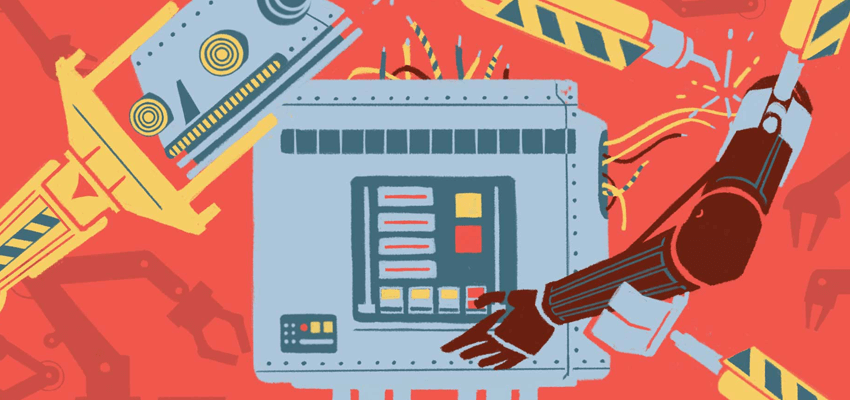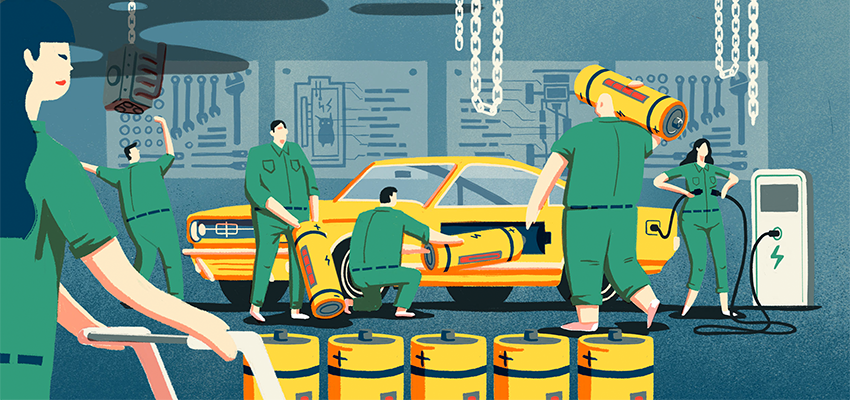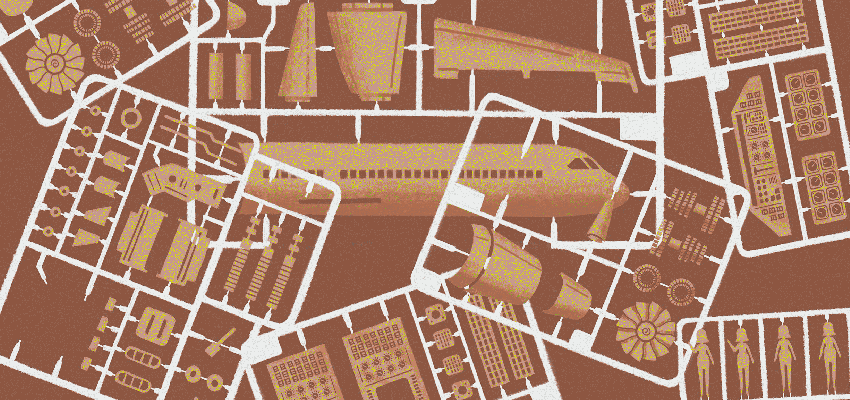Made in China 2025 |
您所在的位置:网站首页 › made in china! › Made in China 2025 |
Made in China 2025
|
SECTIONS
Home
Infographics
Hong Kong
China
Asia
World
Business
Tech
Life
Culture
Sport
Most popular
Newsletters
Why ‘Made in China 2025’ triggered the wrath of President Trump
September 11, 2018
The Chinese government announced the ‘Made in China 2025’ strategic plan in 2015. Aimed at closing the gap with Western hi-tech prowess and lessening China’s dependency on imported technology, it specified 10 areas where the country should take the lead. But as the trade war between the US and China heated up in mutual rounds of punitive tariffs, the plan became a focus of Washington’s discontent with Beijing the first of three phases, ‘Made in China 2025’ is a ten-year plan The realityAfter the meteoric rise of recent years, China’s economy now faces a number of potential issues. Maligned as ‘big, but not powerful’, the manufacturing sector in particular has reached a bottleneck, with a slowdown in sales of cheap exports like shoes and toys. Many of these products have reached market saturation and it is hard to keep sales buoyant in sectors requiring little innovation or hi-tech development. What is more, the country’s working-age population is expected to fall sharply by 2030 as a result of the ‘one-child’ policy ‘MADE IN CHINA’ CHANGES China travelled a long and hard road to establish itself as the world’s largest export economy, and the ‘made in China’ tag is now assigned to more sophisticated products than was the case two decades ago. In 1996, Chinese exports were largely textiles and footwear. But by 2016, computers, telephones and other electrical devices began to dominate the export list  Top ten products China exported
Top ten products China exported  China's exports in categories
China's exports in categories 
* “Animal hides” and “Mineral products” are combined into one category ** “Others” includes foodstuffs, vegetable products, animal products, stone and glass, wood products, paper goods, animal and vegetable bi-products, weapons, precious metals StrategyTo realise the plan, the Ministry of Industry and Information Technology has set up ‘five principles, five major tasks’, focusing on improving 10 key manufacturing sectors TEN KEY SECTORS The plan highlights 10 key prioritised industries including robotics, new energy and green vehicles. China sets the targets as follows: Robotics Robots and key parts with IP rights to supply 70 per cent of domestic market. Models of the next generation of robots to be developed and put to use on a certain scale. One to two companies to rank among the top five in the world. New generation information technology Handful of companies becomes top-tier internationally. 14-20nm design and manufacturing technique will be achieved. Domestically-produced mobile communications equipment meets 80 per cent and 40 per cent of domestic market and international market demand respectively. Aviation and aerospace equipment China aims to have domestically produced commercial aircraft and turboprop regional airliners to supply to 10 per cent and up to 20 per cent of mainland Chinese market and international market respectively. Major development work of prototype of large aircraft engine to be completed. Maritime equipment and hi-tech ships China to have more than five internationally renowned manufacturing companies. Maritime equipment to supply 40 per cent of international market. Hi-tech ship design and manufacturing equipment to supply 50 per cent of the international market. Breakthrough to be achieved in key design, manufacturing, testing and installing technologies for under water production systems. Railway transport Overseas business to account for 40 per cent with China occupying the high end of the value chain for global railway transportation. New energy and energy-saving vehicles Domestic products with IP rights to supply 50 per cent of domestic market. Fuel consumption of passenger vehicles will not exceed 4L/100km, self-sufficiency rate for key parts to exceed 60 per cent. China aims to export 20 per cent of all commercial vehicles and have three companies that are ranked in the top five for sales internationally. Energy equipment Globally competitive companies of energy equipment to be established. China aims to reach globally advanced level in producing large-scale thermal power, hydropower and nuclear power equipment. New energy and renewable energy equipment with original IP rights to account for 80 per cent of market. Industry size of power electric power transmission to reach three trillion yuan. Agricultural equipment Industrial output aims to reach 800 billion yuan and China will become the world's biggest agricultural equipment maker. Domestically manufactured equipment will meet 95 per cent or more of Chinese market demand. Automation technologies and equipment to reach advanced international standards. New materials Domestically produced basic materials products should meet 90 per cent of local demand. Biopharma and hi-tech medical devices Biopharma innovative development and production to reach international standards. Industrial output of medical devices to reach 1.2 trillion yuan. 85 per cent of core components of devices to be domestically manufactured. Commercialisation of innovative chemical medicines and Chinese medicines to be achieved. Robotics Robots and key parts with IP rights to supply 70 per cent of domestic market. Models of the next generation of robots to be developed and put to use on a certain scale. One to two companies to rank among the top five in the world. New generation information technology Handful of companies becomes top-tier internationally. 14-20nm design and manufacturing technique will be achieved. Domestically-produced mobile communications equipment meets 80 per cent and 40 per cent of domestic market and international market demand respectively. China aims to have domestically produced commercial aircraft and turboprop regional airliners to supply to 10 per cent and up to 20 per cent of mainland Chinese market and international market respectively. Major development work of prototype of large aircraft engine to be completed. Maritime equipment and hi-tech ships China to have more than five internationally renowned manufacturing companies. Maritime equipment to supply 40 per cent. High-tech ship design and manufacturing equipment to supply 50 per cent of the international market. Breakthrough to be achieved in key design, manufacturing, testing and installing technologies for under water production systems. Railway transport Overseas business to account for 40 per cent with China occupying the high end of the value chain for global railway transportation. New energy and energy-saving vehicles Domestic products with IP rights to supply 50 per cent of domestic market. Fuel consumption of passenger vehicles will not exceed 4L/100km, self-sufficiency rate for key parts to exceed 60 per cent. China aims to export 20 per cent of all commercial vehicles and have three companies that are ranked in the top five for sales internationally. Energy equipment Globally competitive companies of energy equipment to be established. China aims to reach globally advanced level in producing large-scale thermal power, hydropower and nuclear power equipment. New energy and renewable energy equipment with original IP rights to account for 80 per cent of market. Industry size of power electric power transmission to reach three trillion yuan. Agricultural equipment Industrial output aims to reach 800 billion yuan and China will become the world's biggest agricultural equipment maker. Domestically manufactured equipment will meet 95 per cent or more of Chinese market demand. Automation technologies and equipment to reach advanced international standards. New materials Domestically produced basic materials products should meet 90 per cent of local demand. Biopharma and hi-tech medical devices Biopharma innovative development and production to reach international standards. Industrial output of medical devices to reach 1.2 trillion yuan. 85 per cent of core components of devices to be domestically manufactured. Commercialisation of innovative chemical medicines and Chinese medicines to be achieved. Share this storyINDICATORS The results of ‘Made in China 2025’ will be evaluated by 12 indicators in the four following areas. Here we list one example for each category: 1. Innovation Research and development (R&D) revenue expenses Percentage of sales allocated to R&D expenditure 
2. Product quality Growth rate of improved quality The projected growth rates due to improved manufacturing quality are two and four per cent points higher than the rate in 2015 
3. Digitalisation Broadband internet penetration The projected penetration rates of 70 per cent by 2020 and 82 per cent by 2025, means 400 million and 480 million households will have access to broadband internet, respectively 
4. Green production Decrease of CO2 Emission Carbon dioxide emission is expected to decrease from 2015 by 22 per cent in 2020 and 40 per cent in 2025  Long way to go
Long way to go
SATELLITES IN ORBIT The first Chinese satellite, ‘Dong Fang Hong’, was launched In 1970. Today, there are 311 Chinese satellites in orbit, about one-fifth of the US, but China aspires to increase long-term and stable spatial information services like satellite remote sensing, communication and navigation  
 
Pujiang-z1 In 2015, China successfully launched ‘Pujiang-1’ to help promote and monitor the construction of smart cities. It is the first satellite to feature 3D printed parts. Developed by the Shanghai Academy of Spaceflight Technology, the frame inside the satellite was made using 3D printing  
Ziyuan III-02 The satellite ‘Ziyuan III-02’ was launched in 2016. A remote sensing satellite monitoring land use, natural disasters and water resources, it will join ‘Ziyuan III-01’ (launched in 2012) to form a network capturing high-definition, 3D multi-spectral images Jan, 2018 How the mainland went from ‘Made in China’ to ‘Created in China’ROBOTICS SUPPLY In 2016, 74 per cent of robot sales were represented by five markets, with China accounting for the lion’s share at 30 per cent of the total. Beijing aims to boost technology production and sales by achieving automation and digitisation in the manufacturing sectors by producing 100,000 of its own industrial robots by 2020  
INDUSTRIAL ROBOTS China is banking on automation and digitisation to improve productivity and set it on a trajectory to become one of the world’s 10 most automated nations. The country ranked well below the world average for industrial robot density in 2016, but Beijing aims to have 150 units per 10,000 employees by 2020   CHINA
CHINA
More on China news A wealth of insight about China ChallengesTRADE SURPLUS AND DEFICIT China’s exports of hi-tech goods increased steadily after reform policies began and by 2004 their value had already already exceeded US exports. The Trump administration argues the trade deficit between China and the US is a result of unfair competition. The ‘Section 301 investigation’ also accuses China of stealing intellectual property from American companies ChallengesTRADE SURPLUS AND DEFICIT China’s exports of hi-tech goods increased steadily after reform policies began and by 2004 their value had already already exceeded US exports. The Trump administration argues the trade deficit between China and the US is a result of unfair competition. The ‘Section 301 investigation’ also accuses China of stealing intellectual property from American companies HEAVY RELIANCE ON OTHER COUNTRIES China currently lacks the ability to make many key electronic components and relies on other countries to supply many hi-tech parts. ‘Made in China 2025’ aims to have 70 per cent of essential spare parts manufactured domestically to resolve the issue TRADE WAR On July 6, 2018, the US started implementing 25 per cent tariffs on $34 billion worth of Chinese goods. It is targeting 818 products central to Beijing’s ‘Made in China 2025’ initiative, particularly technological parts. The table below illustrates how China’s prioritised sectors are being hit: Jun, 2018 Beijing tries to play down ‘Made in China 2025’ as Donald Trump escalates trade hostilities RELATED STORIESBeijing tries to play down ‘Made in China 2025’ as Donald Trump escalates trade hostilities How the mainland went from ‘Made in China’ to ‘Created in China’ Made in China 2025 By South China Morning Post Graphic Team Part 2. How China aims to dominate the world of robotics
Part 2. How China aims to dominate the world of robotics
By Marco Hernández  Part 3. How Beijing is boosting its semiconductor industry
Part 3. How Beijing is boosting its semiconductor industry
By Marcelo Duhalde  Part 4. How China plans to be a world leader in Artificial Intelligence
Part 4. How China plans to be a world leader in Artificial Intelligence
By Pablo Robles  Part 5. Betting big on biotech
Part 5. Betting big on biotech
By Adolfo Arranz  Part 6. China sees 5G as gateway to the industrial internet
Part 6. China sees 5G as gateway to the industrial internet
By Marcelo Duhalde  Part 7. The stones in the road for China’s 2025 plan on electric vehicles
Part 7. The stones in the road for China’s 2025 plan on electric vehicles
By Marco Hernández  Part 8. Can ‘Made in China 2025’ help turn its domestic aerospace industry into a world leader?
Part 8. Can ‘Made in China 2025’ help turn its domestic aerospace industry into a world leader?
By Dennis Wong South China Morning Post special feature by: Alice Tse, [email protected] Julianna Wu, [email protected] in collaboration with: Adolfo Arranz, Marco Hernandez and Darren Long SourcesThe State Council of the People's Republic of China, United States Census Bureau, Ministry of Human Resources and Social Security, The Observatory of Economic Complexity, N2YO, International Federation of Robotics, World Bank South China Morning Post September 11, 2018 Enjoying South China Morning Post graphics?Here are some other digital native projects you might want to visit Or just visit our graphics home page Home Infographics Hong Kong China Asia World Business Tech Life Culture SportThis site has some features that may not be compatlibe with your browser. Should you wish to view content, switch browsers to either Google Chrome or Mozilla Firefox to get an awesome experience |
【本文地址】
今日新闻 |
推荐新闻 |
 by AliceTse
by AliceTse
 JuliannaWu ‘Made in China’ is often associated with cheap and poor quality goods, but Beijing has ambitious plans to transform itself into an innovative hi-tech powerhouse by 2025
JuliannaWu ‘Made in China’ is often associated with cheap and poor quality goods, but Beijing has ambitious plans to transform itself into an innovative hi-tech powerhouse by 2025